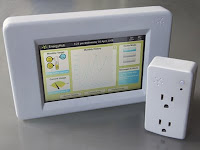Most of our clients are interested in how much energy their new green home will use. Wireless energy monitors are the answer. Here's an article I read recently in Business Week:
Bringing Smart Energy Home: Wireless energy dashboards to monitor usage are coming to many U.S. homes starting this year, fueled by the stimulus package, by Katie Fehrenbacher
Thanks to funds from the stimulus package and renewed attention to energy savings, 2009 is the year companies are planning to launch wireless energy dashboards that will sit in your home, monitor energy data from your electricity meter, and let you know if you're being an energy hog. While tech firms have been trying to sell you on the "digital home" for years—complete with wireless networks that can do everything from control your entertainment equipment to operate high-tech security systems and roast a chicken—the new energy-management companies are keeping it simple by using low-cost hardware and open standards to monitor energy data.
 This year is particularly important to these mostly young companies, as President Barack Obama has pledged to help utilities install 40 million smart meters, which are basically digital meters that create a two-way connection with the power grid and the utility. Smart meters installed in homes can unleash data about the fluctuating price of electricity throughout the day, enabling consumers that have energy-management tools to shift energy consumption to the time of day when power is cheapest. For utilities, that can mean better management of the power grid, eliminating the need to build out expensive power generating systems.
This year is particularly important to these mostly young companies, as President Barack Obama has pledged to help utilities install 40 million smart meters, which are basically digital meters that create a two-way connection with the power grid and the utility. Smart meters installed in homes can unleash data about the fluctuating price of electricity throughout the day, enabling consumers that have energy-management tools to shift energy consumption to the time of day when power is cheapest. For utilities, that can mean better management of the power grid, eliminating the need to build out expensive power generating systems. 
In the U.S., 6% have smart meters
A half-dozen companies are launching their first energy dashboards this year and a few others are starting to gain traction with already available online tools. One of the biggest differences between these firms is whether companies will sell directly to the consumer or to utility partners for upcoming smart meter rollouts. Several of the already available options for consumers bypass smart meters and utilities and just help the interested consumer with a standard electricity meter. They're cheap and available online, but they provide less detailed data.
 The utility-focused tools use smart meter information to provide deeper energy analysis and can even control smart appliances, enabling utilities to implement demand-response events. But the drawback of such tools is that you'll need a lot of patience and a little luck. To get hooked up via one, you'll need to be in the footprint of a utility that's rolling out smart meters. At this point fewer than 6% of the U.S. population has a smart meter.
The utility-focused tools use smart meter information to provide deeper energy analysis and can even control smart appliances, enabling utilities to implement demand-response events. But the drawback of such tools is that you'll need a lot of patience and a little luck. To get hooked up via one, you'll need to be in the footprint of a utility that's rolling out smart meters. At this point fewer than 6% of the U.S. population has a smart meter. 









